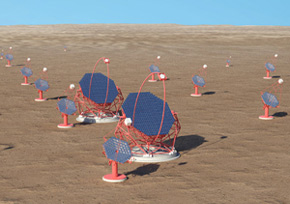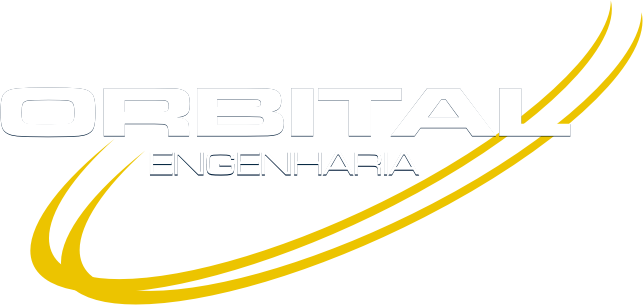Telescope Mechanical Arm (CTA)
Photo: Disclosure
By Elton Alisson
Agência FAPESP – A group of approximately one thousand researchers from 28 countries, including ten Brazilians, intends to build by 2015 the largest observatory in the world dedicated to the study of celestial bodies that emit gamma radiation – the highest energy radiation.
Called the Cherenkov Telescope Array (CTA), the observatory will be installed in two different locations, one in the Southern Hemisphere and the other in the Northern Hemisphere.
Chile, Argentina and Namibia are candidates to host the experiment. In the Northern Hemisphere, the United States and Spain have already expressed interest. The choice of venues will be decided by the end of 2013.
The observatory will have one hundred ground-based telescopes sensitive to gamma radiation, distributed equally across both hemispheres. The equipment will operate together, oriented to observe a single celestial body at a time, such as supernova remnants, galaxies with an active nucleus and quasars that emit gamma radiation. As a result, the precision of studying these celestial objects will be much greater than what is currently available.
“The only gamma astronomy observatory in operation today – the Hess Observatory [High Energy Stereoscopic System], installed in Namibia – has five telescopes operating together. The CTA will be able to measure the gamma radiation produced during astrophysical phenomena with ten times greater sensitivity”, said Luiz Vitor de Souza Filho, professor at the São Carlos Institute of Physics (IFSC) at the University of São Paulo (USP) and one of the researchers Brazilians participating in the project, to Agência FAPESP.
According to Souza Filho, Brazilian researchers are very interested in the type of astrophysics that the CTA will study, which connects traditional astrophysics with particle astrophysics (cosmic rays).
This is because the experiment will make it possible to increase understanding of how this radiation is emitted, how these particles propagate and can be detected and how celestial bodies that emit gamma rays with energy between 10 GeV and 100 TeV are formed, among other issues. In addition to producing knowledge, Brazilian scientists also intend to contribute to the construction of CTA instrumentation.
“It is almost mandatory that a member country that wants to have access to the data generated by the experiment on an equal basis with other members has to contribute to the construction. Because of this, we are developing two instrumentation projects for the CTA”, said Souza Filho.
Carried out with support from FAPESP, one of the projects is aimed at developing the coating for the mirrors that will cover the telescopes, which have the function of reflecting light and at the same time protecting the equipment from adverse weather conditions.
As it will be exposed in the atmosphere, the reflecting part of the telescopes will have to last a long time and be very well made, so that it does not come loose from the glass and affect the reflective and protective properties of the mirror.
To ensure that this does not happen, a group of IFSC researchers, under the coordination of Souza Filho, is investigating aluminization techniques and deposition of reflective and protective surfaces for the CTA telescope mirrors in partnership with the company Opto Eletrônica.
“The mirrors will not need to be as precise as those in the optical telescopes installed in observatories in Chile operated by the European Southern Observatory [ESO], but they will have to last much longer,” explained Souza Filho.
Another project in the instrumentation part of the CTA that will count on the contribution of Brazilian researchers is the development of metallic structures of sustentação aos telescópios.

Around 16 meters long, these structures need to support a set of electronic instruments that weigh 2.5 tons at their ends and cannot extend more than 20 millimeters to avoid damaging the images produced by the telescopes.
Through a project carried out in partnership with the company Orbital Engenharia, from São José dos Campos, in the interior of São Paulo, the researchers designed a structure that was approved by the international collaboration involved in the construction of the CTA – Orbital had several projects supported by the FAPESP Innovative Research in Small Businesses Program (PIPE).
“We already had know-how in building this type of instrumentation due to the development of technologies very similar to these. that we designed for the Pierre Auger observatory, in Argentina”, said Souza Filho.
IFSC researchers are currently developing prototypes for the mirror coating and mechanical structure of the telescopes, which should be completed by 2013 so that the CTA can begin construction in 2013 and enter into operation in 2015.
In addition to the IFSC group, researchers from the Institute of Astronomy, Geophysics and Atmospheric Sciences (IAG) at USP, the Federal University of São Carlos (UFSCar), the Federal University of ABC (UFABC), the Brazilian Center for Physical Research (CBPF) and the Federal University of Rio de Janeiro (UFRJ).
Broad research scope According to Souza Filho, the CTA’s research scope will be quite broad. In the area of astrophysics, some of the themes that can be explored through the new observatory are black holes and star-forming regions.
In the area of particle physics, through the project, Lorentz variance breakdown studies can be carried out – a very specific test of restricted relativity. “Through the observatory, it will be possible to carry out the most restricted test of relativity that has ever been carried out to date at long distances and on long scales”, estimated Souza Filho.
In addition, the observatory should be dedicated to searching for regions that are candidates for concentrations of dark matter and identifying new extraterrestrial sources emitting high-energy gamma rays. Today, around one hundred sources are known, a number that could multiply with the CTA.
“The scientific scope of the new observatory is impressive and has a double aspect. At the same time as it will make it possible to study more important questions for astrophysics, the experiment should also expand knowledge in the physics of elementary particles”, assessed Souza Filho.
To choose which possible locations should host the observatory, a call was launched which established, among the minimum conditions necessary to host the experiment, that the region must have a very clean atmosphere, be at least 2 thousand meters above sea level. , there is no light contamination and there is little formation of rain and clouds. In Brazil there is no region with all these characteristics.

